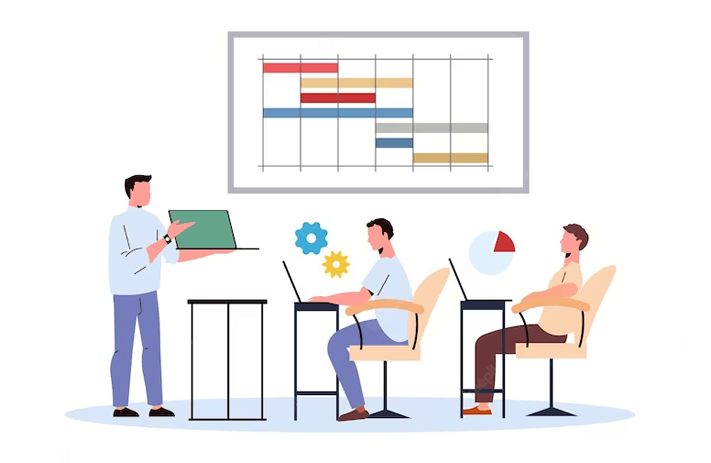
Click the button to start reading
Examples of Inclusion in the Workplace: How to Promote Inclusivity At Work
Feeling included is as human as needing to eat and drink water. As social creatures, we genuinely crave attention and acceptance from the others in our lives.
Inclusion has been sought after since we were cavemen. In fact, even in prehistoric times, our ancestors got busy with gossip, an easy way to connect with others and share information.
Now, we’re not suggesting a gossip culture equals inclusion at work because that’s more likely to cause a rift among staff. But highlighting the importance of human connection is how businesses move towards a more inclusive workplace.
Let’s do a little experiment.
Think back to your first job; maybe it was working retail or at a fast food place. Your old boss had their favorites, right? The ones who would also get the best shifts or could take longer breaks.
Maybe there was a clique who seemed above the rules, always working together and putting distance between themselves and the other workers.
It was a hostile environment, wasn’t it? People were treated differently, and it was impossible to raise these concerns because the boss didn’t care.
Inclusion in the workplace is all about tackling these kinds of problems to create teams that are more connected. In this article, we’ll be going through inclusion in the workplace examples and helping you identify what your office is guilty of and what to do about it.

What is Inclusion in the Workplace?
An inclusive workplace is somewhere that places a greater emphasis on creating a welcoming environment and encouraging involvement from all people regardless of differences.
Today, we enjoy greater access to the global workforce, which means people are entering the workplace with vastly different experiences and backgrounds. Inclusion is how companies become more interconnected with their staff while ensuring those hired are the best for the role rather than hiring based on stereotypes.
Creating inclusive workplaces has been a priority for many companies over the last 100 years. But it’s important to acknowledge the work still to be done. Leaders looking to develop a more inclusive place of work understand the benefit of diversity among their staff.
Below is a list of aspects of inclusion in the workplace targets:
- Age
- Disabilities
- Mental Health
- Gender identity
- Sexual orientation
- Ethnic background
- Socio-economic status
- Religious and cultural background
Inclusive companies look to hire and nurture their employees by putting aside unconscious biases, instead placing proper emphasis on a person’s skills, experience, potential for growth, and commitment to the business.
Removing obstacles from a person’s development at the company allows managers to get better work at their team. Important factors like staff loyalty, productivity, and team cohesion receive a significant boost, and an inclusive culture at work can reduce the levels of staff turnover.
People want to feel respected at work, and the aspects mentioned above are important parts of personality. Although someone’s background and gender don’t impact their ability to work, it does inform their experiences and perspectives. Tapping into a more diverse range of viewpoints brings invaluable and irreplaceable insights.
Inclusion vs. Diversity and Equality
When inclusion in the workplace is discussed, it’s not uncommon to hear the terms diversity and equality used interchangeably. All three are heavily interconnected, but they have disparate meanings worth understanding.
- Inclusion: Inclusion focuses on creating a workplace where all employees feel valued and respected. The employer should undertake policies that promote a safe environment where every person can thrive and embrace their individual qualities without fear of discrimination from others.
- Diversity: Diversity puts greater emphasis on hiring employees from a wide range of backgrounds and characteristics. A diverse team would include people of different races, genders, ages, and other aspects. However, a diverse hiring policy alone doesn’t equate to inclusion if not everyone is given the same platform to contribute to the company and access opportunities for development.
- Equality: Equality means offering fair treatment to all employees regardless of their backgrounds and demographics. For example, ensuring employees at the same level receive the same compensation package irrespective of gender or nationality. Doing so gives staff the same tools they need to be successful.
Diversity and equality help leaders create a more inclusive workplace, but they don’t go far enough on their own. All three form a strong foundation for a positive and productive workplace environment.
Now, let’s go through various scenarios where a company can develop inclusion in the workplace.

Examples of Inclusion in the Workplace
suddenly champion inclusivity. It requires a culture shift from the top down and needs to affect every division and every team.
In the examples below, we’ll go through the obvious areas where inclusion will make a difference, as well as more subtle scenarios where its impact is more easily overlooked.
Inclusive Hiring Policies
Hiring is the first time a prospective candidate will interact with your company, and setting a good example here can encourage more interest from high-quality prospects. If a job advert or an interview fails to feel inclusive, good people may choose to walk away from the opportunity.
However, hiring policies are an excellent way to demonstrate your commitment to inclusivity to potential candidates. Here are some of the ways to achieve this:
- Blind recruitment: A person’s demographics aren’t important in hiring, and the process should reflect this. Develop a system where identifying information is removed from applications and can’t be used to influence decisions during the screening process. If the application will involve a skills test, ensure this is standardized across all applicants.
- Inclusive language: The language used in a job advert should avoid using gendered language. Instead of using he or she in the advert, switch to they or ‘the candidate’ as this will feel more welcoming to all applicants.
- Offering flexibility: Flexible working conditions are a sought-after benefit for modern candidates. If there is scope for flexibility in the job, offering this recognizes that people have different needs. It allows employees to balance work with their personal lives better and reduces the amount of stress. Naturally, this can lead to more productivity and shows people trust and understanding, which is rewarded with loyalty and hard work.
- Examine job description: Potential candidates come from a range of backgrounds that may not fit neatly into educational boxes. Focus on their experience and qualifications rather than specific degrees. People from non-traditional backgrounds have diverse skills that can benefit a role and are just as worth considering alongside those with a relevant degree.
- Diverse interviewers: When an interview panel is part of the hiring process, companies should include managers from diverse backgrounds. Diversity helps to reduce individual biases in the interview process and allows different perspectives to decide whether a candidate is a good fit. Additionally, train those involved in interviews on unconscious bias and the importance of equitable evaluation.
- Optimized onboarding: Once a candidate is hired and their onboarding starts, inclusion should remain at the forefront. Include a diversity and inclusion training program early in their development. Also, consider implementing a work shadowing or mentorship program, which can pair people from diverse backgrounds together to help acclimatize new staff to the company.
- Create feedback systems: It’s not always possible to identify inefficiencies in the hiring process internally. To combat this, create channels where prospective candidates and new hires can provide feedback on the recruitment process. Doing so will open up new insights and highlight areas of improvement.
When hiring, you want to bring on the best of the best, and developing more inclusive hiring policies encourages more applications from experienced candidates. The best person for the job may be put off applying if the job advert and selection process don’t feel inclusive, which means you miss out on their expertise.
Development and Networking Opportunities
Employees should be offered the same access to training and development resources. This includes removing barriers that limit opportunities to those in senior positions. Appropriate adjustments should also be made for employees with accessibility needs. No one should miss out on professional growth opportunities due to the physical or cognitive challenges they may face.
It’s important to run team-building activities, too, especially for larger workforces. Not only does it deepen the connection between employees, but opens up internal networking opportunities that can benefit a person’s career growth and collaborative projects.
Some ideas for inclusive team activities include:
- Volunteering: Volunteering is a great way for companies to show they’re dedicated to corporate social responsibility while letting employees come together for the greater good. It helps people to learn more about the causes in their communities and spend a day outside of the office with their peers. Many volunteering opportunities include teamwork and problem-solving to overcome challenges.
- Language exchange: If you have team members who speak different languages organizing workshops can be a great way to upskill staff. A company that deals internationally or is looking to expand its sales regions will benefit greatly by encouraging its workforce to learn another language.
- Book clubs: Book clubs can be an excellent source of camaraderie and education. Books can be selected that share cultural messages or provide the foundations for career development. Each month the members of the book club come together to share their thoughts and discuss their takeaways from what they’ve read.
- Walking lunches: Encouraging exercise at work can benefit people’s mental and physical well-being, but walking lunches, in particular, can provide an opportunity for members of different teams to develop rapport. It can be a great way for upper management and staff to connect on a personal level, breaking down hierarchical and cultural barriers.
- Skill-sharing workshops: Much like the language exchange, skill-sharing workshops are run by staff with specialist skills with the aim of upskilling their colleagues. These skills range from important at-work skills like marketing, mathematics, and coding to more hobby-based skills like cooking, yoga, and painting.
- Seminars: Arranging seminars from outside speakers is an excellent way to bring new ideas into the workplace. Instead of only inviting senior managers or specific teams, open invitations to the entire organization so no one is excluded from something they might enjoy attending.
- Escape rooms: Escape rooms are a team-building exercise where people must work together to figure out a series of puzzles. By teaming up with others from across departments and management levels, people can build a deeper bond as they take on the challenges of the escape room.
- Trivia nights: Trivia nights are a fun activity where staff can come together to relax away from the pressure of their job. People will be put into teams and use their knowledge to answer questions. Trivia nights also present a sly opportunity to introduce concepts from different cultures, which can get people talking and asking questions.
All in all, the goal of development and networking opportunities is to make sure no one is shut out from something that benefits their professional or personal growth. Every member of staff should be offered equal access to support and resources.
Inclusive Work Environment
An office should be a welcoming place to everyone, not just staff but contractors, clients, and other visitors. No place of work should feel alienating to those walking through the site. The first thing to concentrate on is whether your place of work is safe for all members of staff.
Unconscious bias can get in the way of safety at work, so empathy is needed to put yourself in the shoes of others. Here are some examples of safe and inclusive work environments:
- Providing accessible infrastructure, including ramps, elevators, and accessible bathrooms.
- Providing gender-neutral bathrooms
- Creating a private space for prayer
- Designating quiet zones where staff can take a break
- Providing a nursing room for new parents
- Buying adjustable desks and chairs
- Buying visual and audio aids like hearing loop systems and screen magnifiers
- Implementing temperature control zones
Being able to provide each of the above may depend on the space available in your office. If the space is there, these features in an office go a long way to making a safe space for everyone. However, when we talk about an inclusive work environment, there’s much more to consider than just the infrastructure.
Examples of inclusive behaviors at work:
- Team meetings: In team meetings, make sure every voice has a chance to be heard. There will naturally be some strong personalities in the team who can easily end up taking over if others fail to speak up. Encourage participation from everyone and provide opportunities for a range of voices to be heard.
- Celebrating holidays and milestones: Make sure all holidays are part of the corporate calendar so everyones heritage and religion is given equal attention. Events like Pride Month, Black History Month, Christmas, Hanukkah, and a diverse range of other celebrations are treated on equal footing. This also means celebrating personal milestones like birthdays, promotions, and anniversaries.
- Equitable pay schemes: Equal pay is important among staff, so the company should avoid a biased pay structure to boost inclusion in the workplace. Compensation should be fair and transparent. If pay gaps exist, then you need to uncover what’s caused them and address these issues.
- Ask questions: A company dedicated to inclusion should never stop asking questions. Approach employees about their thoughts on inclusion initiatives and see if they have any ideas for consideration. Try to do this as a routine to reduce the risk of stepping backward with inclusivity.
- Open door policy: Managers should have an open door policy and encourage staff to come to them with any concerns. A manager should want to hear from all different viewpoints on their team. If staff can come to their with concerns or suggestions, this can quickly lead to a more harmonious and productive workplace.
Creating an inclusive work environment is an ongoing process that should be informed by the staff. As new people join an organization, inefficiencies in inclusion may reveal themselves, and a business dedicated to inclusion will try to act quickly.
Conclusion
Inclusion in the workplace helps to bring out the best in people. When staff feel safe and respected at work, they’re more likely to stay in the job longer, reducing turnover and the cost of training.
When everyones needs and culture are addressed, it removes barriers from work so everyone can focus on their roles without fear.
Unconscious biases exist at all levels, so it’s important that inclusion initiatives are conducted from a panel of diverse backgrounds to avoid any one person making all the decisions. If this can be achieved, the entire organization benefits as a result.
















